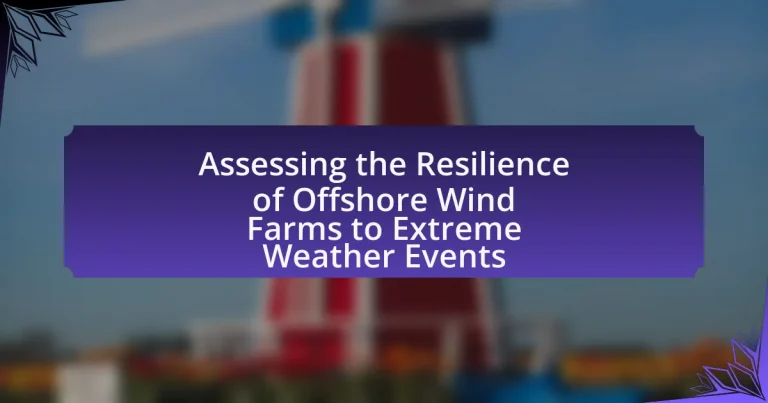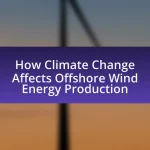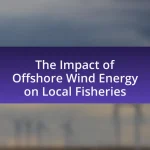The article focuses on assessing the resilience of offshore wind farms to extreme weather events, highlighting their robust design and engineering standards that enable them to withstand high winds and severe marine conditions. It defines resilience in this context as the ability to endure, adapt to, and recover from environmental stresses while maintaining operational efficiency. Key factors contributing to resilience include advanced materials, structural integrity, and real-time monitoring systems. The article also discusses the importance of resilience assessments, methodologies used for evaluation, and best practices for enhancing the durability and reliability of offshore wind farms in the face of climate change and extreme weather challenges.
What is the resilience of offshore wind farms to extreme weather events?
Offshore wind farms exhibit significant resilience to extreme weather events due to their robust design and engineering standards. These facilities are constructed to withstand high winds, heavy seas, and other severe conditions, often incorporating features such as reinforced foundations and advanced materials. For instance, the design criteria for offshore wind turbines typically account for wind speeds exceeding 60 meters per second, which is higher than most recorded storm conditions. Additionally, studies have shown that offshore wind farms can continue to operate effectively even during adverse weather, with many installations reporting minimal damage during events like hurricanes. This resilience is further supported by ongoing monitoring and maintenance practices that ensure the structural integrity and operational capacity of the turbines in challenging environments.
How is resilience defined in the context of offshore wind farms?
Resilience in the context of offshore wind farms is defined as the ability of these installations to withstand, adapt to, and recover from extreme weather events and environmental stresses. This definition encompasses not only the structural integrity of the wind turbines and associated infrastructure but also the operational capacity to maintain energy production during and after such events. Research indicates that offshore wind farms are designed with specific engineering standards to enhance their resilience, including robust foundations and advanced materials that can endure harsh marine conditions, thereby ensuring continued functionality and safety.
What factors contribute to the resilience of offshore wind farms?
The resilience of offshore wind farms is primarily influenced by their design, technology, and operational strategies. Robust structural engineering ensures that turbines can withstand extreme weather conditions, such as high winds and waves. Advanced materials, like corrosion-resistant coatings, enhance durability against harsh marine environments. Additionally, real-time monitoring systems allow for proactive maintenance and rapid response to changing weather patterns, thereby minimizing downtime. Research indicates that offshore wind farms designed with these factors in mind can significantly reduce the risk of damage during severe weather events, as evidenced by the performance of existing installations during storms.
How does resilience impact the operational efficiency of offshore wind farms?
Resilience significantly enhances the operational efficiency of offshore wind farms by enabling them to withstand and quickly recover from extreme weather events. This capability minimizes downtime and maintenance costs, ensuring that energy production remains stable even during adverse conditions. For instance, studies have shown that resilient offshore wind farms can maintain up to 90% of their operational capacity during storms, compared to less resilient counterparts that may experience a 50% reduction. Such resilience not only optimizes energy output but also contributes to the overall reliability of renewable energy sources in the grid.
Why is assessing resilience important for offshore wind farms?
Assessing resilience is crucial for offshore wind farms because it ensures their ability to withstand extreme weather events, thereby maintaining operational efficiency and safety. Offshore wind farms are exposed to harsh environmental conditions, including high winds, waves, and storms, which can lead to structural damage and operational downtime. For instance, a study by the National Renewable Energy Laboratory indicates that resilient designs can reduce maintenance costs and increase the lifespan of wind turbines by up to 20%. Therefore, evaluating resilience not only protects investments but also supports the reliability of renewable energy sources in the face of climate change.
What are the potential risks associated with extreme weather events?
Extreme weather events pose significant risks, including damage to infrastructure, disruption of energy supply, and threats to human safety. For instance, hurricanes can lead to the destruction of offshore wind farms, resulting in substantial economic losses; the National Oceanic and Atmospheric Administration reported that hurricanes caused over $50 billion in damages in 2020 alone. Additionally, extreme weather can disrupt maintenance operations, leading to prolonged downtimes and reduced energy output. Furthermore, flooding and high winds can endanger workers and nearby communities, highlighting the need for robust safety measures and resilient designs in offshore wind farm construction.
How can resilience assessments mitigate these risks?
Resilience assessments can mitigate risks to offshore wind farms by identifying vulnerabilities and enhancing preparedness for extreme weather events. These assessments evaluate structural integrity, operational protocols, and environmental factors, allowing for targeted improvements. For instance, a study by the National Renewable Energy Laboratory found that implementing resilience strategies can reduce downtime by up to 30% during severe storms, thereby minimizing financial losses and ensuring energy supply continuity.
What methodologies are used to assess the resilience of offshore wind farms?
The methodologies used to assess the resilience of offshore wind farms include structural analysis, risk assessment, and simulation modeling. Structural analysis evaluates the physical integrity of wind farm components under extreme weather conditions, ensuring they can withstand forces such as high winds and waves. Risk assessment identifies potential hazards and evaluates the likelihood and impact of extreme weather events on operational performance. Simulation modeling uses computer-based simulations to predict how offshore wind farms will respond to various extreme weather scenarios, allowing for the optimization of design and operational strategies. These methodologies collectively provide a comprehensive understanding of resilience, enabling stakeholders to make informed decisions regarding the safety and efficiency of offshore wind farms.
What are the key indicators of resilience in offshore wind farms?
The key indicators of resilience in offshore wind farms include structural integrity, operational reliability, and adaptive capacity. Structural integrity refers to the ability of wind turbines and associated infrastructure to withstand extreme weather conditions, such as high winds and flooding. Operational reliability indicates the consistent performance of the wind farm during adverse weather, measured by uptime and energy production metrics. Adaptive capacity reflects the facility’s ability to implement changes or upgrades in response to new challenges, such as technological advancements or evolving climate conditions. These indicators are essential for ensuring that offshore wind farms can maintain functionality and safety during extreme weather events.
How do simulation models contribute to resilience assessments?
Simulation models enhance resilience assessments by providing a systematic approach to evaluate how offshore wind farms respond to extreme weather events. These models simulate various scenarios, including wind speeds, wave heights, and operational conditions, allowing for the analysis of potential impacts on infrastructure and performance. For instance, studies have shown that simulation models can predict failure rates and downtime under specific storm conditions, enabling stakeholders to identify vulnerabilities and improve design and operational strategies. By quantifying risks and facilitating informed decision-making, simulation models play a crucial role in enhancing the resilience of offshore wind farms.
How do extreme weather events affect offshore wind farms?
Extreme weather events can significantly impact offshore wind farms by causing structural damage, operational disruptions, and increased maintenance costs. For instance, hurricanes and severe storms can lead to the failure of turbine components, such as blades and gearboxes, as well as damage to the foundations and electrical systems. A study by the National Renewable Energy Laboratory found that wind farms located in areas prone to extreme weather may experience a reduction in energy production by up to 30% during such events. Additionally, the costs associated with repairs and downtime can escalate, affecting the overall economic viability of these renewable energy projects.
What types of extreme weather events pose the greatest threat?
Extreme weather events that pose the greatest threat include hurricanes, tornadoes, and severe storms. Hurricanes, characterized by high winds and heavy rainfall, can cause significant damage to infrastructure, including offshore wind farms, as evidenced by Hurricane Sandy in 2012, which resulted in over $70 billion in damages. Tornadoes, with their intense wind speeds, can destroy structures and disrupt energy production, as seen in the 2011 Joplin tornado that caused extensive destruction. Severe storms, including thunderstorms and heavy rainfall, can lead to flooding and operational challenges for wind farms, impacting their resilience and energy output.
How do these events impact the structural integrity of wind turbines?
Extreme weather events significantly compromise the structural integrity of wind turbines by subjecting them to intense forces and conditions. High winds can lead to excessive stress on turbine components, potentially causing fatigue and failure in critical areas such as the tower, blades, and foundation. For instance, research indicates that hurricanes can produce wind speeds exceeding 150 mph, which can exceed the design limits of many turbines, resulting in structural damage or complete collapse. Additionally, heavy precipitation and flooding can undermine the foundation stability, further jeopardizing the turbine’s integrity. These impacts underscore the necessity for robust engineering designs that account for extreme weather scenarios to ensure the longevity and safety of offshore wind farms.
What are the best practices for enhancing the resilience of offshore wind farms?
The best practices for enhancing the resilience of offshore wind farms include robust design standards, regular maintenance, and advanced monitoring systems. Implementing design standards that account for extreme weather conditions, such as high winds and waves, ensures structural integrity. Regular maintenance schedules help identify and rectify potential vulnerabilities before they lead to failures. Advanced monitoring systems, utilizing real-time data analytics, allow for proactive responses to changing environmental conditions, thereby minimizing downtime and damage. These practices are supported by industry guidelines, such as those from the International Electrotechnical Commission, which emphasize the importance of resilience in offshore wind farm operations.
How can design modifications improve resilience against extreme weather?
Design modifications can significantly enhance resilience against extreme weather by incorporating advanced materials, structural reinforcements, and adaptive technologies. For instance, using corrosion-resistant materials and flexible joints in offshore wind farms can withstand high winds and wave impacts, reducing the risk of structural failure. Research indicates that implementing aerodynamic designs can minimize wind load, thereby improving stability during storms. Additionally, integrating real-time monitoring systems allows for proactive adjustments to operations, further safeguarding infrastructure against unpredictable weather patterns.
What role does technology play in enhancing resilience?
Technology plays a crucial role in enhancing resilience by providing advanced monitoring, predictive analytics, and adaptive systems that improve the response to extreme weather events. For instance, offshore wind farms utilize real-time data collection through sensors and satellite imagery to assess environmental conditions, enabling operators to make informed decisions about maintenance and operational adjustments. Research indicates that the integration of machine learning algorithms can predict equipment failures and optimize energy production, thereby reducing downtime during adverse weather. This proactive approach not only safeguards infrastructure but also ensures continuous energy supply, demonstrating the effectiveness of technology in bolstering resilience against extreme weather challenges.
What lessons have been learned from past extreme weather events affecting offshore wind farms?
Past extreme weather events affecting offshore wind farms have highlighted the importance of robust design and engineering standards. For instance, the impact of Hurricane Sandy in 2012 on offshore wind infrastructure demonstrated the need for enhanced structural integrity to withstand high winds and wave forces. Additionally, the lessons learned emphasize the necessity of comprehensive risk assessments and contingency planning, as evidenced by the operational disruptions experienced during severe storms. These events have also underscored the value of real-time monitoring systems to provide data for immediate response and long-term improvements in resilience strategies.
What case studies illustrate successful resilience strategies?
Case studies illustrating successful resilience strategies in offshore wind farms include the Hornsea One project in the UK and the Block Island Wind Farm in the US. Hornsea One, operational since 2020, has demonstrated resilience through advanced design features that withstand extreme weather, including robust turbine structures and strategic site selection to minimize storm impact. The Block Island Wind Farm, operational since 2016, utilized innovative anchoring systems and real-time monitoring technologies to adapt to changing environmental conditions, showcasing effective risk management and operational continuity during severe weather events. These examples highlight the importance of engineering advancements and proactive planning in enhancing the resilience of offshore wind farms against extreme weather.
How have past events shaped current resilience assessment practices?
Past events, particularly extreme weather incidents, have significantly influenced current resilience assessment practices for offshore wind farms. For instance, the impact of Hurricane Sandy in 2012 prompted a reevaluation of structural integrity and operational protocols, leading to the development of more robust assessment frameworks. These frameworks now incorporate lessons learned from historical failures, such as the 2005 damage to offshore structures during Hurricane Katrina, which highlighted vulnerabilities in design and emergency response. Consequently, resilience assessments now emphasize adaptive strategies, real-time monitoring, and predictive modeling to enhance preparedness for future extreme weather events.
What future trends are expected in the resilience assessment of offshore wind farms?
Future trends in the resilience assessment of offshore wind farms include the integration of advanced predictive analytics, enhanced modeling techniques, and the incorporation of real-time monitoring systems. These advancements aim to improve the ability to anticipate and respond to extreme weather events, thereby increasing the operational reliability of offshore wind farms. For instance, the use of machine learning algorithms can analyze historical weather data to predict potential impacts on wind farm structures, while real-time sensor data can provide immediate insights into the performance and condition of equipment during adverse conditions. Additionally, regulatory frameworks are evolving to emphasize resilience, prompting developers to adopt more rigorous assessment methodologies that account for climate change projections and extreme weather scenarios.
How might climate change influence the resilience of offshore wind farms?
Climate change may reduce the resilience of offshore wind farms by increasing the frequency and intensity of extreme weather events such as storms and sea-level rise. These changes can lead to structural damage, operational disruptions, and increased maintenance costs. For instance, a study by the National Renewable Energy Laboratory indicates that rising sea levels can inundate coastal infrastructure, while stronger storms can exceed the design limits of existing wind turbine structures, necessitating upgrades or replacements to maintain operational integrity.
What innovations are on the horizon for improving resilience assessments?
Innovations on the horizon for improving resilience assessments of offshore wind farms include advanced predictive analytics, real-time monitoring systems, and the integration of machine learning algorithms. These technologies enhance the ability to forecast extreme weather impacts and assess structural integrity. For instance, predictive analytics can utilize historical weather data and operational performance metrics to model potential failure scenarios, while real-time monitoring systems equipped with IoT sensors provide continuous data on environmental conditions and structural responses. Machine learning algorithms can analyze vast datasets to identify patterns and optimize maintenance schedules, thereby increasing the resilience of wind farms against extreme weather events.
What practical steps can stakeholders take to ensure the resilience of offshore wind farms?
Stakeholders can ensure the resilience of offshore wind farms by implementing robust design standards and conducting regular maintenance. Robust design standards, such as those outlined by the International Electrotechnical Commission (IEC), help structures withstand extreme weather conditions, including high winds and flooding. Regular maintenance, including inspections and repairs, is essential for identifying vulnerabilities and ensuring that all components function optimally. Additionally, stakeholders should invest in advanced monitoring technologies that provide real-time data on structural integrity and environmental conditions, enabling proactive responses to potential threats. These steps collectively enhance the operational reliability and longevity of offshore wind farms in the face of extreme weather events.




